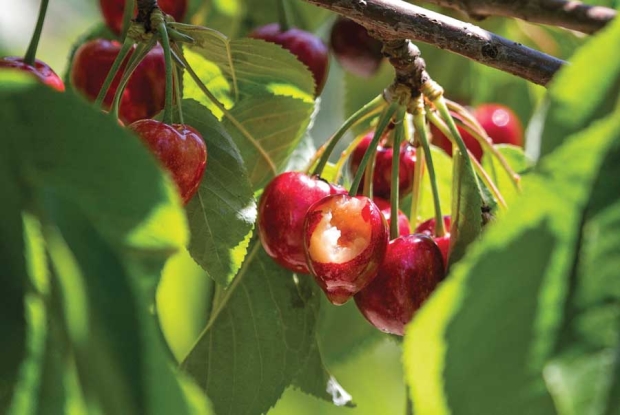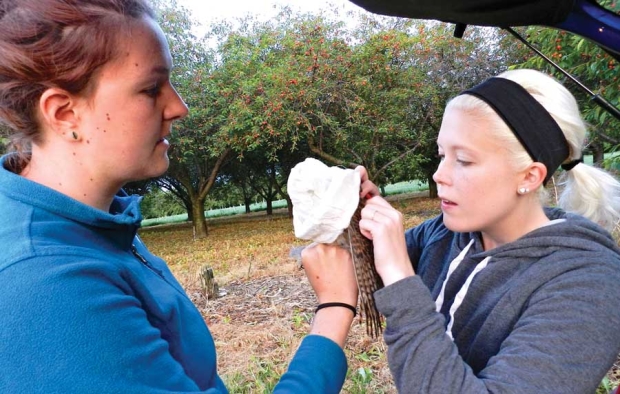
Unfortunately for growers, cherries are often a favorite snack for birds. Researchers are using new findings to help limit damage. (TJ Mullinax/Good Fruit Grower)
Cherry growers sometimes feel like they’re growing fruit mainly for the birds, but there is new information that can help them make informed decisions about bird management, said Catherine Lindell at the Michigan State University Integrative Biology Department and Center for Global Change and Earth Observations.
She presented the results of a variety of studies at the Great Lakes Fruit, Vegetable and Farm Market EXPO, held in December in Grand Rapids, Michigan.
The location of an orchard can make a big difference in the amount of bird damage sustained, she said.
She and her research group considered cherry blocks that were surrounded by additional cherry orchards, by some other land cover, such as a forest or pasture, or by a mix of cherry orchards and other land covers.
They analyzed bird damage over three years — 2012, 2013 and 2014 — and found that blocks that were isolated and did not have edges abutting other sweet cherries tended to have higher damage in all those years.
The findings suggest that because there is less alternative fruit in that immediate area, the birds key in on cherries, which leads to a higher-percent damage, she said.
Growers with early-ripening varieties would experience the same thing because, similarly, the birds would have fewer alternative food sources, she added.
She also noted that orchard sites that have more resources for birds experience greater damage. For instance, she said, farms that supply cover from predators will support larger cherry-eating bird populations, as will farms with streamside vegetation suitable for roosting.
Another possible resource is the presence of overhead wires for perching birds.
“Although we haven’t found a real clear pattern with wires in sweet cherries, we did find higher levels of bird damage in Honeycrisp apple blocks that were below wires compared to blocks that were without wires.”
In addition, Lindell and her research group looked into different bird-management options. One was the hanging of dead birds or effigies to deter cherry-eating birds.
Preliminary data show that the effigies appear to attract birds rather than repel them, she said. “We did not combine this with something like firing off a shotgun to (help the birds) associate these effigies with something bad, so there’s still a possibility that by combining effigies with some other deterrent, their effectiveness might be improved.”

Graduate student Megan Shave (right) led a monitoring effort from 2013-2015 to determine usage of next boxes by American kestrels, small falcons that prey on nuisance birds, plus other animals such as meadow voles and insects that can damage young trees and/or fruit. Here, Shave is examining a kestrel with the help of undergraduate student Emily Oja. (Courtesy Catherine Lindell)
They also looked into the addition of nest boxes to attract beneficial birds, particularly American kestrels (small falcons sometimes called sparrow hawks), which prey on nuisance birds and other animals such as meadow voles and insects that can damage young trees and fruit.
Through a monitoring effort of nest boxes in 2013-2015, led by graduate student Megan Shave, they found nearly 100 percent occupancy by kestrels.
Using a 30-day nesting period, Lindell extrapolated that the kestrel pairs monitored would remove thousands of insects and numerous birds and mammals from the area.
Although nest boxes can be very successful, they will not solve entire pest problems, she said. Nonetheless, she added, “This looks like a nice, low-cost, low-maintenance contribution to integrated pest management.
“The bottom line is, assess the risk, decrease your resources and manage for detrimental birds, and increase your resources for beneficial predators.” •
– by Leslie Mertz






I grow sour cherries and have ZERO bird problems. Why? I hang red plastic ‘cherries’ in the trees and leave them in the tree the whole year around, replacing them as they fade. Also, I put red painted stones in the strawberries as soon as blooming is finished. The birds peck on the rocks, hurt their beaks and don’t come back. AND I hang raspberry shaped berry beads around the perimeter of the red raspberry patch as soom as blooming is done. It doesn’t work 100% but it helps. Black berry beads do not work with blackberry and black raspberry and I don’t know why not.